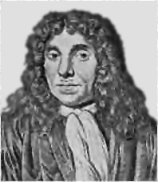|
懷孕
- 歷史記載 |
|
1. 人類精子的發現 |
 |
|
安東·範·列文虎克
A. van Leeuvenhoek
(1632 - 1723)
|
|
|
|
安東·範·列文虎克是荷蘭商人,他後來成為一名透鏡磨制專家和業餘科學家。他用自己製作的顯微鏡觀察了許多種液體、組織和礦物,並且在當時向科學權威人士通報了他的發現。1677年,他觀察了自己的精液,成為第一個在一滴精液裏看到人體精子的人。但是,他相信每一個精子細胞已經包含了人體“預成型的”狀態,是一個潛在的完整人體。正象17和18世紀裏在多種醫學插圖中所繪製那樣,這個觀點在許多年裏得到了科學家們的普遍認可。 |
|
(左)列文虎克按照他看到的自己所繪製的精子細胞。(右)在列文虎克之後,其他人的繪圖。在卵細胞發現之前,許多科學家相信精子細胞的頭部含有一個全部的“預成型的”小人(矮人)。
|
|
(Left)
Leeuvenhoek’s
own
drawing
of
the
sperm
cells
he
saw.
(Right)
Drawings
made
by
others
after
Leeuvenhoek’s
discovery.
Before
the
discovery
of
the
egg
cell,
many
scientists
believed
that
the
head
of
each
sperm
cell
contained
a
fully
“preformed”
little
person
(homunculus).
|
|
|
Conception
- Historical Notes 1. Discovery of Human Sperm Cells
Antonius van
Leeuvenhoek was a Dutch
businessman who became an expert lens
grinder and amateur scientist. With a
self-built microscope, he investigated
various liquids, tissues, and minerals
and corresponded about his discoveries
with the scientific authorities of his
time. In 1677, examining his own
ejaculate, he was the first to see
living human sperm cells in a drop of
semen. He believed, however, that each
sperm cell already contained, in a
"preformed" state, the entire
potential human being. This belief was
shared by many scientists for many
years, as various medical illustrations
made in the 17th and 18th centuries
show.
|